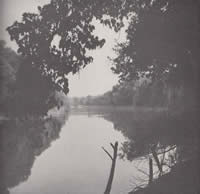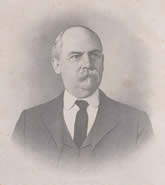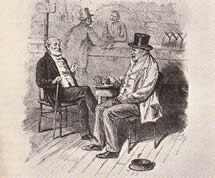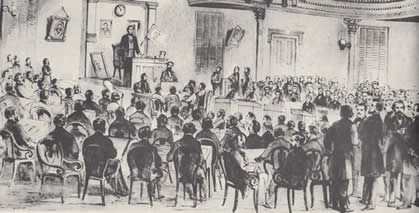North Carolina War Between the States Sesquicentennial

Roanoke River
The Halifax Secession Movement of October 1860
The importance of the Halifax Resolves of 1775 to North Carolina and American history is
underscored by their date being emblazoned on today’s State flag. The Halifax committee
established in October 1860 for the very same purpose of liberty and independence followed
the secession example set by New England’s Hartford Convention of 1814.
Though the majority of North Carolinians were reluctant to withdraw from the Union after the election
of a purely sectional president, the citizens at Halifax quickly perceived the danger to their political
liberty and took the action they saw necessary.
The following is transcribed in full from the October, 1917 issue of the North Carolina Booklet,
published by The North Carolina Society, Daughters of the Revolution.
First Southern Secession Movement of 1860 in North Carolina:
“The late Dr. W.R. Wood, Superintendent of the [North Carolina] Asylum, some years ago
sent me the enclosed letter, with the proceedings of the first meeting declaring secession (in imitation
of the Mecklenburg Declaration) ever held. This Declaration antedated the South Carolina Declaration
more than two months. It was on 14 October 1860, and that of South Carolina was on
December 20 of that year. This is a valuable historical document, and, being from that section,
I know the statements therein are entirely accurate.
Walter Clark

Hon. Walter Clark, Raleigh, North Carolina.
My Dear Judge: -- I herewith confide to your especial care – In Memoriam of a past age
and a lost cause – the Minutes of the first declaration of secession ever formulated and
promulgated in the Southern States.
The history of the first declaration of secession principles have never been written, and
therefore has never been generally known. Mecklenburg with her declaration of 1775 has
been oft recorded in letters of living light, high on the pages of fame’s immortal scroll
in the New World’s history. Therefore, and wherefore should not this second movement
in behalf of constitutional liberty and the sovereign rights of a chivalrous people, by the
sages of old Halifax, in the startling era of the sixties, be handed down to our posterity in
the history of American martyrs and Southern heroism.
Perhaps in the remote future, amid the changes wrought by time in the destinies of States,
it may come to pass, that the actors in the opening drama of 1860, who, thus launched forth
this declaration of secession in defiance of a World in Arms, will be considered something
more than irrational impulsive visionaries or impetuous fire eaters.
With sentiments of distinguished consideration and esteem, I am,
Very truly your friend, William R. Wood, Scotland Neck, Oct. 14, 1888.
A Chapter of History
"Transactions of the first secession movement and declaration of the first secession resolutions ever
held in the Southern States, at Palmyra, Halifax County, North Carolina, October 14, 1860.

Pursuant to previous notice issued for the purpose of eliciting an expression of opinion relative to
the action of the people of North Carolina in the event of the certain election of a sectional President,
the citizens of Halifax and adjoining counties of Edgecombe, Martin and Bertie assembled “en masse”
at Palmyra on the 14th instant. The meeting was largely composed of men of character, of influence
and standing in their separate communities. General David Clark, Thos. Jones, Samuel Hyman,
A.P. Hyman, L.L. Savage, Henry B. Whitmore, Kenneth Thigpen, Dr. William R. Wood, W.R. Cherry,
and other kindred spirits were early on hand voicing the sentiments of our people in no uncertain words.
Crowds of men, of all conditions and walks of life, from the great slaveholders of the Roanoke Valley
to the humblest, poorest man in the neighborhood, thronged the village and adjacent groves,
manifesting deep and serious interest in the great momentous questions of the times.
The meeting was called to order by the Hon. Kenneth Thigpen of Edgecombe. Thos. Jones, Esq.,
of Martin was nominated to the Chair and A.P. Hyman of Palmyra appointed Secretary.
The Chairman in a brief, incisive speech pointed out the evils of the hour, and with a master’s hand
portrayed in gloomy colors the threatening troubles hanging like a dark funeral pall over the institutions and
destinies of the Southern people.

After Mr. Jones had explained the object and interest of the meeting, Gen’l David Clark of Halifax
was called on to give his views of the situation. The general was particularly happy in the manner
and delivery of his remarks, and in a spirited, stirring talk of a few moments completely captured
the audience, creating quite a sensation and electrifying his hearers
by exclaiming in language most prophetic:
“Gentlemen, Lincoln will be elected, all you hold dear, your wives, your children, your property
and your sacred honors, are at stake. The hour has struck, the enemy is upon us. The time for action,
decisive action, is at hand. The powers of evil have all combined against us to rob us of our
substances and dishonor us in our manhood. We must act, act in the living present with all the
sublime courage of heroes and martyrs.
There is nothing stands between us now and our deadliest foes. The abolitionists and disunionists
of the New England States, for the Democrats have played the devil and the Whigs have gone to hell.”
This brought down the house and the General retired amid a storm of applause.
General Clark was followed by the young, impassioned and uncompromising advocate of secession,
Dr. William R. Wood of Scotland Neck, in a political argument on the right of secession, beginning
with the Hartford Convention and closing with in an eloquent and scathing philippic against Northern
abolitionists, and in concluding, declared it the imperative duty of North Carolina to at once withdraw
from the Federal Compact and joining her Southern sisters, seek, with them an alliance, offensive
and defensive, with the powers of Great Britain. And if necessary to preserve and protect her people
from Northern aggression and domination, renew her allegiance to the British Crown.
This open defiance against Northern supremacy again brought down the house, but also
brought our Chairman, Mr. Jones, to the floor. Requesting the venerable Samuel Hyman to
take the chair, Mr. Jones made a ringing speech against an alliance with England,
advocating with force and effect his “pet idea,” an alliance, offensive
and defensive, with the Emperor of France.
The debate waxed fast and furious for a few moments on these two propositions of Dr. Wood
and Mr. Jones, and for awhile considerable merriment and confusion ensued, but debate was cut
short and order restored by the ever-ready, gallant Kenneth Thigpen, who in a few stirring,
startling words impressed the importance of the occasion upon the convention and demanded
the appointment of a committee to formulate a platform of resolutions giving emphatic
expression to the views of the people.
Upon that committee, the following gentlemen were appointed by the Chair: Hon. Kenneth Thigpen,
Gen’l David Clark, Thos. Jones, Esq., Dr. William R. Wood, and Lem. L. Savage, Esq.
As a guest of Mr. Jones, Mr. Whitmel Kearney of Warren, who was present and whose people were
known to be in sympathy with the movement, was by unanimous consent added to the committee.
These gentlemen retired, and after considerable time and much consultation, reappeared and
announced the following preamble and resolutions:
“1st. Whereas, The people of the Northern section of our common country are forcing through the
legislatures of their several States, with all the elements of implacable hatred, so-called
personal liberty bills . . . subverting the constitution of our fathers, and openly threatening the
most sacred interests and institutions of the Southern States by declaring that instrument which
binds this Union together as coequal sovereigns a covenant with death and a league with hell.
And, Whereas, The Republican party has proclaimed itself a sectional party, pledged to wage
relentless war against the institutions of the South:
Therefore, Resolved, That whereas the Republican States of New England were the first
to proclaim secession, we will profit by their example, and their language in the Hartford Convention.
Declare: That “when emergencies occur which are either beyond the reach of the Judicial tribunals,
or too pressing to admit of the delay incident to their forms, States which have no common umpire,
must be their own judges and execute their own decisions.”
Resolved, 2nd. That henceforth we renounce all allegiance to the United States Government,
and appeal to our Legislature to call a convention for the purpose of withdrawing North Carolina
from the Federal Compact and negotiating with other Southern States in forming alliances offensive
and defensive with the Emperor Napoleon the III of France.
Before a vote was taken on the committees’ report, Dr. Wood, through a member of the committee,
appealed to the convention to vote down Mr. Jones’ French resolutions, and
offered the following as a substitute:
Resolved, That as North Carolinians, we disown, disavow, and utterly repudiate all allegiance to
the so-called Federal Government, and demand the unconditional withdrawal of North Carolina from
the Federal Compact, and for the better preservation of her sovereignty as a free and independent
State, unite with her Southern sister States in forming an alliance offensive and defensive with
the powers of Great Britain, and if necessary to protect her people from Northern aggression
and domination, renew her allegiance to the British Crown.

After considerable debate between the parties advocating the French and English propositions,
Dr. Wood’s resolution was voted down. The preamble and resolutions as they came from the
committee were unanimously adopted and the convention adjourned.
A.P. Hyman, Secretary. Samuel Hyman, Sr., Chairman
Dr. W.R. Wood, Scotland Neck
My Dear Doctor: -- The above is but a rough sketch in pencil of our great Secession Convention
in 1860. Try and copy them off as best you can and preserve it in memory of old friends and a lost cause.
Your friend, A.P. Hyman, Palmyra, A.D. 1866.
The above is a truthful transcription of the rough notes referred to by my late father,
A.P. Hyman, Secretary of the meeting at that time, as copied out in full by the undersigned
at the request of Dr. Wood. A.P. Hyman, Jr., Scotland Neck, August 25, 1888.
Source:
The First Secession Movement, North Carolina Booklet,
Volume XVII, No. 2, October 1917, Commercial Printing Company, pp. 90-95
Copyright 2013, North Carolina War Between the States Sesquicentennial Commission